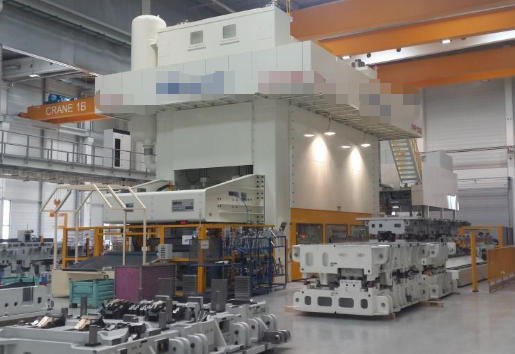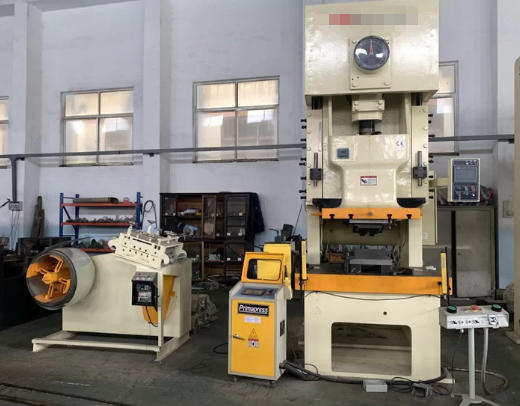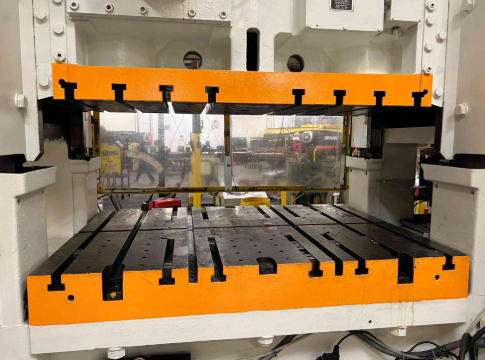Views: 222 Author: Rebecca Publish Time: 2025-11-17 Origin: Site









Content Menu
● What is a Punch Press Machine?
● Types of Punch Press Machines in Kitchenware Manufacturing
● How Punch Press Machines Shape Kitchenware Components
>> Step 3: Forming and Bending
>> Step 4: Finishing and Trimming
● Integration of Punch Press Machines in the Production Line
>> Material Feeding and Coil Handling
>> Robotic Handling and Transfer Stations
>> Inline Measurement and Quality Control
>> Maintenance and Tooling Efficiency
● Technological Advancement and Digital Upgrades
>> Servo-Electric Drive Technology
>> AI and Predictive Algorithms
>> IoT Connectivity and Cloud Monitoring
● Economic Impact of Punch Press Automation in the Kitchenware Industry
● Sustainable Manufacturing Through Punch Press Optimization
● Equipment Selection and Configuration Strategies
● Future Prospects for Smart Kitchenware Manufacturing
● FAQ
>> 1. What types of kitchenware are commonly produced using punch press machines?
>> 2. How do CNC punch presses differ from traditional models?
>> 3. What is the impact of servo-electric drives on kitchenware production?
>> 4. Are automated punch press systems suitable for both large and small manufacturers?
>> 5. How does predictive maintenance enhance punch press reliability?
In the competitive world of kitchenware manufacturing, efficiency, consistency, and innovation define success. Whether it is stainless-steel pots, aluminum frying pans, or custom-cut utensils, each product starts from a simple sheet of metal that must be shaped and refined with utmost accuracy. The backbone of this process is the punch press machine—a workhorse that transforms raw materials into perfectly formed kitchenware components.
Modern manufacturing facilities rely heavily on the precision of these machines, which combine mechanical engineering with digital intelligence. Punch presses enable producers to meet rising global demand for high-quality, affordable, and sustainable cookware. Their ability to automate complex forming operations not only ensures precision but also accelerates production efficiency across entire kitchenware lines.
This article explores how punch press machines function, their integration in modern production, and why they remain the cornerstone of metal-based kitchenware manufacturing.

A punch press machine is a metal forming tool designed to punch holes, cut shapes, or deform sheets through compressive force. It uses a punch and die assembly to apply thousands of kilograms of pressure per stroke. In kitchenware production, the precision offered by these machines determines the uniformity, aesthetic quality, and durability of the final cookware piece.
Punch presses serve multiple applications across manufacturing lines, including:
- Blanking and cutting sheet metal into cookware-sized pieces.
- Piercing precise handle holes or drainage openings.
- Forming contours or curved surfaces in pots, bowls, or lids.
- Embossing decorative and brand-specific patterns.
The integration of automation and digital control allows for continuous production runs with minimal downtime, aligning with the just-in-time manufacturing philosophy widely adopted in modern factories.
Choosing the right punch press depends on material type, desired product geometry, and production capacity. In kitchenware manufacturing, three main categories dominate industrial use.
A mechanical punch press operates using an electric motor and flywheel that store kinetic energy, delivering rapid punches per cycle. Mechanical presses are particularly suited for aluminum cookware, stainless steel utensils, or decorative components requiring high-speed punching.
Their key features include:
- Stroke rates exceeding 400 per minute.
- Consistent force and accuracy during short strokes.
- Cost efficiency in mass production settings.
- Compatibility with progression die systems for multiple operations per pass.
Many large-scale cookware manufacturers use mechanical presses for tasks like punching ventilation holes in pans or preparing steel disks for spinning into kitchen bowls.
Hydraulic punch presses rely on pressurized fluid to apply force evenly throughout the stroke. This makes them ideal for deeper or more complex forming of kitchenware shapes, such as deep salad bowls or cooking pots that require greater tensile control.
Advantages include:
- Adjustable pressure settings for diverse material thickness.
- Uniform force delivery to prevent tearing during deep drawing.
- Quieter, smoother operation and longer die lifespan.
- Superior control for thick-gauge stainless steel or copper.
Hydraulic presses are invaluable when cookware designs require depth, symmetrical thickness, or multi-step forming operations.
CNC (Computer Numerical Control) turret punch presses are a fusion of precision engineering and software automation. They can perform multiple operations—punching, nibbling, embossing, and forming—without manual intervention.
Features include:
- Automated tool rotation with multi-station turrets.
- High-speed precision punching guided by CAD design.
- Error-free repetition with minimal material waste.
- Integration with robotics and automated handling systems.
CNC press technology is the driving force behind smart kitchenware lines, where every component is mapped, monitored, and optimized for lean production.

Modern punch press systems handle more than simple cutting. They orchestrate a series of complex operations that transform raw sheets into finished cookware parts. The process typically follows four key stages.
Blanking involves cutting large sheets into smaller, manageable pieces or blanks. These blanks match the basic outline of the cookware product—circular for pots and pans, rectangular for trays, or custom for specialty utensils. Advanced punch presses optimize material nesting to minimize scrap, contributing to sustainable operations and cost savings.
In cookware with handles, rivets, or drainage features, precise piercing is essential. CNC punch presses can pierce multiple holes in one operation, ensuring perfect alignment for assembly and welding in later stages. Producers often combine piercing and embossing to integrate branding or pattern work simultaneously.
Once blanked, sheets are formed into the desired curvature using hydraulic or servo-driven presses. For example, forming pot lids requires shallow dome curves, while deep bowls rely on sequential drawing stages. Advanced presses adjust stroke depth and speed dynamically, maintaining uniform wall thickness and smooth contours.
After shaping, punched cookware components go through trimming or edge-flanging to remove burrs and prepare surfaces for polishing or coating. This stage ensures that every product is safe for consumer use and meets hygiene and food-grade quality standards.
A modern kitchenware production line isn't a collection of independent machines—it's a coordinated system guided by automation, robotics, and data analytics.
Sheet metal from coils enters the press through automatic feeders. Straighteners flatten metal strips before each punch, guaranteeing uniform entry and dimension accuracy. Sensors control tension and feeding speed to synchronize the flow with press cycles.
Robotic arms equipped with suction grippers transfer parts between workstations. This robotic movement not only speeds up production cycles but also eliminates scratches or damages often caused by human handling. Integration with CNC punching systems enhances overall line coordination.
High-speed cameras and laser scanners verify each part's dimensions in real time. Any deviation beyond the tolerance range automatically triggers rejection or adjustment. Consistency across thousands of parts ensures product reliability and brand reputation.
Punch dies require periodic sharpening or replacement. Predictive maintenance software now monitors tool conditions using AI algorithms to schedule maintenance at optimal intervals, minimizing unplanned shutdowns.
Punch press technology has undergone dramatic transformation in the past two decades, from manual mechanical machinery to intelligent Industry 4.0 systems.
Servo-electric presses use electronically controlled motors that can regulate stroke speed and depth dynamically. This technology reduces energy consumption by up to 30% while improving stroke repeatability and forming precision—ideal for cookware items made from delicate aluminum alloys.
Modern CNC punch presses integrate user-friendly touchscreen interfaces, allowing operators to modify punch sequences, stroke adjustments, and program transitions without downtime. Real-time data collection supports digital twin modeling for full-line simulation.
Artificial intelligence optimizes punch sequencing by analyzing thousands of tool combinations. It automatically determines the best punching path to minimize wear on dies, reduce waste, and improve throughput.
Internet-connected presses share performance data with cloud servers, enabling centralized monitoring of multiple factory lines. Engineers can remotely analyze cycle histories, energy use, and accuracy trends, supporting continuous production improvement.
The financial implications of adopting advanced punch press systems are substantial. For medium-to-large cookware manufacturers, automation translates directly into lower costs and faster return on investment.
Key benefits include:
- 25–40% reduction in labor costs through automation.
- Consistent product quality minimizing rework and material waste.
- Increased machine uptime and production scalability.
- Easier customization for client-specific kitchenware designs.
These outcomes align with global shifts toward lean and flexible manufacturing, where factories must adapt to varying market demands while maintaining profitability.
Sustainability is no longer optional. Kitchenware producers must reduce emissions, waste, and energy consumption while maintaining consistency. Modern punch press machines contribute to this mission through intelligent material use and eco-friendly operations.
- Energy Efficiency: Servo and hydraulic systems regulate power use based on load requirements instead of operating at full power continuously.
- Waste Minimization: CNC nesting software maximizes sheet yield, enabling near-zero scrap operations.
- Recyclable Materials: Stainless steel and aluminum offcuts from punch press operations are recycled into new batches.
- Emission Reduction: Electric servo drives emit less noise and heat, promoting a cleaner working environment.
These improvements align with ISO 14001 environmental certification, giving manufacturers a competitive edge when exporting cookware to eco-conscious markets like the EU and North America.
Proper punch press selection depends on production volume, material types, and product design complexity.
1. Material Strength – Stainless steel requires greater tonnage per stroke than aluminum.
2. Production Volume – High-speed mechanical presses suit volume runs, while CNC machines serve mixed-batch flexibility.
3. Tooling Arrangement – Progressive dies reduce setup time by combining cutting and bending stages.
4. Floor Space and Layout – Line design affects automation compatibility and maintenance accessibility.
5. Operator Skill Requirements – CNC systems demand skilled programming but less physical labor.
Strategic equipment configuration ensures each production stage runs smoothly, increasing throughput and reducing operational costs.
Kitchenware production continues to evolve toward complete digitization and customization. The next generation of punch presses will feature deeper AI integration, automated tool calibration, and smarter interfaces that learn from operator behavior.
Future trends include:
- Unified control systems integrating punching, drawing, and trimming into one automated line.
- Self-learning machines that adjust force curves in real time.
- Recyclable metal composites that require adaptive forming technology.
- Virtual training modules in augmented reality for operator education.
As consumer expectations evolve toward design diversity and sustainability, these innovations ensure that manufacturers remain competitive and future-ready.
Punch press machines remain indispensable in modern kitchenware production lines. Their precision, reliability, and adaptability have allowed manufacturers to enhance efficiency while achieving unmatched consistency in cookware quality. The evolution from mechanical systems to intelligent CNC and servo-electric presses has set new benchmarks in manufacturing efficiency and sustainability.
Whether applied to high-speed stamping or detailed forming, punch press machines form the foundation of modern cookware technology. As the global kitchenware industry moves toward digital automation and environmental responsibility, these machines will continue shaping the tools that define everyday culinary experiences.

Punch press machines manufacture a variety of items including stainless steel pots, aluminum frying pans, ladles, baking trays, and pressure cooker components.
CNC punch presses feature digital control systems that eliminate manual setup, allowing multiple punching operations, pattern embossing, and forming in a single automated cycle.
Servo drives provide greater energy efficiency, smoother motion control, and consistent output force—ideal for precision cookware designs with thin or soft materials.
Yes. Modular press systems allow small manufacturers to scale from semi-automatic lines to fully integrated facilities without major infrastructure changes.
Through IoT sensors and software analytics, predictive maintenance forecasts tool wear and service intervals, minimizing unplanned downtime and extending machine life.
Why The Right Punch Press Machine Is Crucial for High-Quality Tableware Production?
Punch Press Machines: The Backbone of Efficient Cutlery Production
How To Choose Between Manual And Automatic Punch Press Machines?
Best Punch Press Machines for Small And Large-Scale Manufacturers
Top Manufacturers of Punch Press Machines for The Tableware Industry
What Are The Key Benefits of Investing in A Punch Press Machine for Your Factory?
How Punch Press Machines Are Revolutionizing The Cutlery Industry?
The Role of Punch Press Machines in Modern Kitchenware Production Lines
Punch Press Machine Vs. Turret Punch Press: What's The Difference?
